|
The
Market Creation Approach to Development
- poverty
alleviation as a business for the poor
Dr. Urs
Heierli
|
The
market creation approach to development combines two aim:
w
supply
useful and affordable products with a high poverty alleviation impact to poor
people
w
To
create a viable business as a private delivery channel, run by poor people.
Other approaches in development co-operation, also deal with opening markets,
but they are quite different. Trade and export promotion seeks to open up
markets for existing products in new regions Transportation projects (roads and
bridges) aim at stimulating trade and opening up markets - again for existing
products - in new regions.
Conventional development program-mes aim at donor partnerships 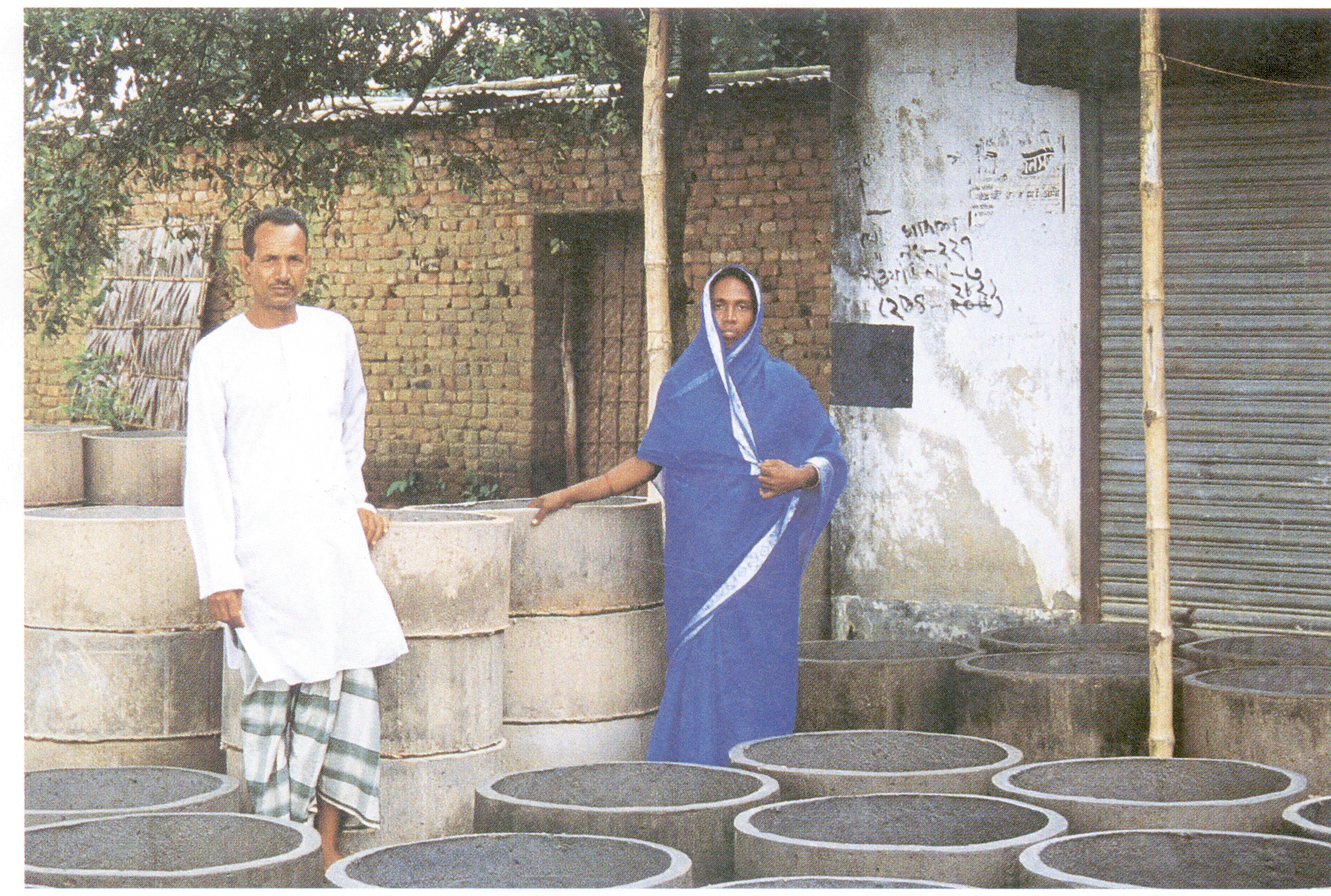 with government
departments or NGOs (or a combination of both), with the objective to deliver
goods or services to the poor. Very often, this delivery channel is subsidised:
the "beneficiaries" may be asked to contribute, but it is often not
possible to recover costs from the "target population".
with government
departments or NGOs (or a combination of both), with the objective to deliver
goods or services to the poor. Very often, this delivery channel is subsidised:
the "beneficiaries" may be asked to contribute, but it is often not
possible to recover costs from the "target population".
Fortunately, marketing is no longer controversial among enterprise specialists.
This has not always been so: in many classical fields of development
(such as water supply, forestry, credit delivery), it is still a new dimension.
A friend of mine, who is anything but dogmatic, expresses it this way:
"most of us in the development field carry a life-long baggage of biases
about profit being bad and traders being the villains of society". This
heritage is averse to the creation of a private supply chain and requires a
shift of mindset. The Indian government, for instance, had set up a state run
delivery system for rural credit with targeted subsidised lending to reduce the
power of the moneylender. Now, this has changed, and private delivery systems
for micro-credit have been allowed - but still do not take savings. In this new
delivery channel middlemen (or "middle women") are playing an
important role in the form of "self-help groups".
Similarly in water supply, the traditional approach of treating water as a free
good which the government has to deliver to everybody like a human right
overshadows reality. Until recently, hand pumps have been centrally procured
world-wide by an agency of UNICEF in Copenhagen. Many projects still delivers
centrally procured handpumps directly to "beneficiaries", thus
preventing private pump dealers to emerge - how can one still wonder why nobody
is supplying spare parts.
Donors and governments view the growth of small enterprises as critical to
coping with the challenges posed by rising unemployment. For at least two
decades, therefore, donors have been supporting the provision of non-financial
services, or ĎBusiness Development Servicesí (BDS). These services include
training and counselling, as well as services to improve access to appropriate
technology, information and markets.
The market creation approach
The market creation approach to development observes BDS principles
but goes beyond them. Whereas a BDS concept would let the "market" or
micro-enterprises choose their products, the market creation approach emphasises
specific products which have a high poverty alleviation impact.
One of the weaknesses of small enterprises is the lack of
capacity to innovate and the technology dualism of micro-enterprises. The focus
of the market creation approach to development is therefore on the following
areas:
w
Need-based
product development,
for products with a high impact on poverty alleviation, stress on affordability
and good returns on
investment
w
Promotion and Marketing of
these products so that the poor can learn about their existence
w
Creation of a sustainable market
to the extent that it becomes viable for the private sector,
ideally micro-enterprises, to deliver these products as a business.
Marketing is the key strategy of this approach. It is thus quite logical to
follow some basic principles, orientations and experiences from the world of
marketing, especially the 4 Pís.
| Product |
what is the product or
service exactly? |
| Price |
how much does it cost? |
| Place |
where can I buy it? |
| Promotion |
how do I make the product
known? |
| The
Six Examples of the Study |
Product: more than just
"hardware"
To understand what the product is may not be so trivial as it looks at first
glance. In the early days of development co-operation, it was even suspicious to
promote a product which looked good, very much in line with Henry Fordís
saying: "you can have it in all colours, provided it is black", I
think, we must learn that people, and especially poor people, have aspirations
and feelings which we should take seriously. When the director of a samba school
in Rio de Janeiro was asked: "Why do (poor) people spend so much money on
these costumes for the Carnival?", he replied: "you know, you rich
people may adore poverty, but we poor people, we love luxury!".
What is the difference between a watch and a Rolex, or between a computer and an
"I-Mac?" Good products are not only rational and useful tools to do
something; good products stand for a lifestyle, they translate feelings and
values.
The definition of the product is highly relevant. For example, in a social
forestry project is the product a tree which gives fodder, fuel or fruits? Or is
it an asset, a savings scheme, a social insurance? These are crucial questions:
it is still the same tree, but consists of an entirely different product as it
is perceived by the customer.
|
|
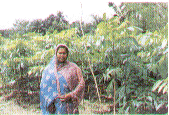
|
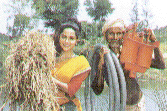
|
|
"Hundred million
trees as a social insurance scheme: the village and farm forestry
programme in Bangladesh" |
"Pedalling out of
poverty with the treadle pump in Bangladesh, India and Nepal" |
|

|

|
|
"60 kilograms more
maize per family with "Postcosecha" in Central America" |
"2000 micro-concrete
roofing workshops produce over 1,50,000 roofs per year" |
|
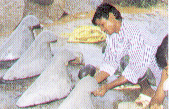
|

|
|
"6000 private
workshops produce over one million latrines per year in Bangladesh" |
"The rope pump in
Central America: the scope for private drinking water supply" |
Price : the art of pricing - what price quality?
Pricing is an art and needs a lot of intuition.
For the poor, products are extremely inelastic on price, i.e. a relatively small
price increase can have a considerable impact on the reduction of sales. This
sensitivity to prices means that quality (connected to higher prices) is not a
universal criteria for purchase by the poor. In the case of the treadle pump,
farmers often prefer to buy cheaper pumps. Attempts to eliminate the cheap and
low quality treadle pumps in Bangladesh have failed: over 50% of the pumps sold
were in the lowest category of quality, lasting only 2 years.
In order to make the supply channel profitable, price differentiation is very
important : A red micro-concrete tile can fetch 7 $, whereas a grey tile may
only be sold at the break-even price of 4$. Increased quality and value addition
raise prices considerably.
Place : The supply channel
Even professional marketers sometimes ask themselves why
intermediaries are needed. An intermediary is a cost factor and needs a profit
margin or a commission. However, sales through a local dealer or representative
are often more effective and even more cost-effective than direct sales. A
strong supply channel is one of the best assets a company can have, and
investing in the loyalty of dealers is a very crucial task of marketing.
Quite often, a dealer provides additional services to the customer such as after
sales service, stocking of spare parts, etc. Sometimes, dealers also provide
credit to their customers because they know the people in the village.
Promotion: Creating awareness about the product
Promotion is more than advertising, it implies a two-way
communication with customers. Rural customers, especially, need to see what they
want to buy. They never buy anything which they have not seen in operation, or -
even better - which their neighbour has not yet already bought. For this reason,
demonstrations represent the most important tool for promotion. Promotion is
however very difficult in rural areas: on the one hand, attending a farmersí
fair ("mela") may reach ten thousand farmers, on the other hand,
geographical distance and low population density make it a costly affair.
Development co-operation can and should support good
promotional efforts with mass media, films, posters, etc. It is difficult to
sustain. Coca Cola is known to everybody, but if it were not continuously
advertised, customers would forget Coca Cola and remember the brand of its
competitors better.
Development co-operation should therefore, seek links to the
corporate sector and tie up products to their supply channel: These companies
may have a long-term interest in promotion if they can sell small amounts on a
regular basis to new customers (like cement companies with roofing tiles,
agro-input companies with micro-irrigation, etc).
Market creation and donor funding
There are several obstacles which make market development in favour of the
poor a tricky and cumbersome task:
w
The
poor are not attractive customers in the short run: they turn
their penny many times before they spend it.
w Poor customers are
very conservative. A market is created only after early adopters have tried a product and many followers have seen and
tested it.
w Cultural
and other barriers hamper the
development of markets for innovative products. For example, it is not accepted
that women would use bicycles or go to the market. Or, the absence of regular
electricity supply is a constraint for marketing electric appliances.
|
Trees,
treadle pumps, rope pumps, maize silos, roofing tiles and latrines can
make a difference to the poor. |
w
The
urban bias of many marketing efforts. Marketing managers prefer to
live in an environment which they know, where they can send their children to
good schools, etc. There are strong biases towards "marketing to the
affluent": One can find several best-sellers with this title, but I could
not trace a single book about "marketing to the poor".
w
The poor cannot afford
to buy big quantities. The most revolutionary marketing idea for
rural markets is a tiny portion packaging, which allows selling small quantities
for an affordable price. a rural retail shop will sell cigarettes by the piece,
shampoo by the "sachet" and beer by the glass.
Why does the private sector not create the markets on
their own?
Market creation is a typical task of marketing, and the corporate
sector does it all the time. However, the small private sector does not invest
in activities such as:
w
research and
product development;
w
setting
- up of marketing and supply channels
w
large-scale
promotion activities leading to the creation of a market
The reason is that the small private sector cannot recover
these costs, because it is difficult to defend the exclusivity of the product.
The private sector will only step in, if the volume of goods sold allow a
profitable supply chain. Initially, it is therefore
justified to subsidise market development. Market development is
even a good investment for development co-operation agencies, provided they do
it correctly.
The problem of cost recovery is especially difficult if we talk about investment
goods or durable goods, because
they may be immediately copied by others. The market provides little
protection against copying: patent protection is not effective and the brand
protection may not be existent either. The conventional strategy against
copying is to distinguish the product from others by branding, but also by
applying high-tech features. In our cases, this is neither possible nor
desirable. Success in development terms, comes from their being copied and
from giving opportunities to small enterprises to produce and sell them.
A good example is the promotion of gas and/or electric stoves in Europe and
America: both were heavily promoted by the gas and the electricity companies,
not by the stove-makers. The gas company is interested in promotion of a gas
stove, because once a household switches to gas, it will remain a customer for
many years. Till today, the gas and electricity companies offer very good
cooking classes in Switzerland, free of cost. A single household converting to
either one of the fuels pays every month a tiny little fee back to the company
for this training course. But how could one do this for the promotion of
energy saving wood-stoves?
Phases of the product-cycle
In marketing theory it is well known that all products undergo four
different phases:
w
In the R&D
phase sales are zero, and only prototypes are produced and tested.
Feedback from test marketing feeds R&D efforts and many products need
considerable adaptation.
wIn the
introduction phase the product needs to be test marketed. Even a
corporate sector
company makes losses in the R&D and introductory
phases that last between 5 and 10 years.
wThe losses incurred in this phase may
not be recovered as it is difficult to achieve exclusivity like in a product developed by the corporate sector. The
R&D costs may be borne by development agencies or donors. Some poverty alleviation is already
taking place with every product sold.
wIn the maturation
phase, the market takes off and demonstration effects lead to higher sales
and higher profits; if the market pioneers can recover the introduction cost
from the channel, more and more units join the channel; The poverty alleviation
effect reaches its peak.
The channel development is linked to micro-enterprise
promotion, and it is often worth including poor people with entrepreneurial
spirit into the channel.
w
In the saturation
phase, the sales of the promoted product decline, profits too, and some
units even withdraw. The withdrawal strategy should now define how to sustain
the channel, by introducing new products or moving to new markets. The poverty
alleviation effect remains at the same high level thanks to the cumulative
adopters.
The time lag of a market creation approach can be extremely
long, and sometimes, success occurs long after one has withdrawn. In Honduras, I
met a hardware shop-owner who supplies chimneys for the "Lorena stove"
in the Yoro region. Apparently, a market has been created for such chimneys, as
they are sold by the thousands. How has this happened? I learnt that the
"Lorena stoves" had been introduced by SDCís "integrated rural
development project" which closed 8 years ago. I then met a lady who had
rebuilt a Lorena stove in her house, just two months ago, and she had learnt the
technique in this project.
The big kick
In the initial phase, market creation may need a kick to
bring it into a more dynamic gear. Without such a "kick", the channel
may well remain "lethargic". Research on the new product diffusion
process based on a study of consumer electronics retailers found that there are
two types of retailers: scouts (innovators) and troops
(followers).
The classification is based on the extent to which one retailer influences
others. Scouts are the first retailers to adopt a new product. They are likely
to commit themselves to a new product, through a small order. On the other hand,
troops purchase a product only when scouts experience satisfactory sales
levels.
In the case of the treadle pump, the product received a
"big kick" from the "Bangladesh Tobacco Company" in Rangpur,
which sold the pump to their contract farmers on a loan basis and recovered the
money though the purchase of tobacco. In the case of the latrines in Bangladesh,
it was the "social mobilisation campaign" which led to the critical
mass which is necessary for troops to join the market channel.
Impact and reach-out of the market creation approach
Market creation programmes can have a very high impact and
reach-out to an impressive number of beneficiaries or - more precisely- clients.
The ultimate success of a market creation approach is a new constellation in the
market, which gives room for a viable supply channel for new products and thus
creates both employment on the supply side and consumer satisfaction on the
demand side Ė if the product really meets the needs of the people.
One of the best examples of a market creation approach with a
very large development impact is the AMUL experience in India: the setting up of
milk co-operatives. "Operation Flood" started in 1970 and had the
specific target to organise 10 million farmers in 30,000 villages and bring them
into the supply channel for milk products which were marketed by AMUL throughout
the country. The charismatic leader behind this landmark programme, Dr. V.Kurien,
has pursued market creation with a lot of ingenuity, with the help of a
conducive policy environment.
The marketing approach is also relatively cost-effective,
since the delivery 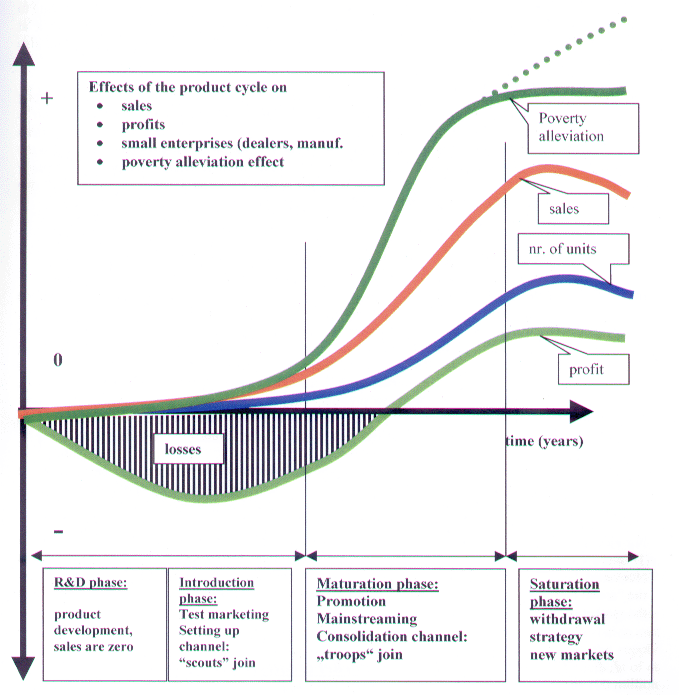 channel is private and profitable, it is sustainable and does
not need direct support. The Village Forestry Programme in Bangladesh will
perform better every year, provided there is no sudden demand saturation for
trees occurring. Each of the 6 projects has a reachout of at least one million
people; one million dollars from donors can generate an output of up to 100
million dollars per year.
channel is private and profitable, it is sustainable and does
not need direct support. The Village Forestry Programme in Bangladesh will
perform better every year, provided there is no sudden demand saturation for
trees occurring. Each of the 6 projects has a reachout of at least one million
people; one million dollars from donors can generate an output of up to 100
million dollars per year.
The above table shows - in a condensed form - the key
performance indicators : the input in terms of donor funds, the output in terms
of economic performance at the level of the "client" (beneficiary),
and the reachout, the number of beneficiaries.
Reasons to scale up and bring the approach into the
mainstream
The above examples are still marginal projects or programmes,
they are not as well known to the development community as the "Grameen
Bank", despite the fact that they have somehow a comparable impact. The
Grameen Bank has 2 million customers, and has received over 100 million dollars
donor input, each of these projects has an impact on a constituency of roughly
one million "beneficiaries" or more, whereas the investment into these
projects has been much lower, to the tune of 7-12 million dollars.
| Performance
indicators for 5 of the 6 projects |
| Project |
Inputs
in $ |
Output
in $ |
Reach-out |
| Forestry Bangladesh |
- 7 m $ in 15 years |
min. 90 m $/year net
present value |
650,000 families |
| Treadle Pump Bangladesh |
- 7 m $ in 15 years |
min. 100 m $/year farmers
profit |
min. 1 m families |
| Maize Silos Central Amer |
12 m $ in 18 years |
min. 6 m $/year savings +
profits |
min. 170,000 families |
| Roofing tiles (global) |
7-10 m $ in 15 years |
12-16 m $/year cheaper
materials |
+ 150,000 new families per
year |
| Latines Bangladesh |
~ 10 m $ for social
mobilisation campaign |
min. 8 m $/year savings in
health |
+ 1.2 m new families per
year |
| m
= million |
Efficiency: very high returns on donor money
The ratio between input and output is very good in all the
examples. The reason for this high efficiency is that the donor has only to
invest in the creation of a space for the private sector to operate. The
delivery channel works on its own initiative, once it is profitable.
Small and micro-enterprises are very cost-effective for all
"local" tasks in the delivery channel, such as manufacturing, selling
and installing simple goods. As long as the supply channel makes profit - even
modest profit-the activity can go on, after withdrawal of donor support as well.
Effectiveness : Can some products make difference to the
poor?
Useful products for the poor can change their lives. Poor
rural women, especially, have not even been considered to be consumers: whereas,
for the work of men a lot of technologies have been introduced, such as
tractors, ox-carts, bicycles, scooters, diesel pumps, women still carry buckets,
walk on their own feet, use sickles and other hand-tools which have very low
productivity. With the introduction of least-cost drip irrigation in the form of
"bucket Kits" in India, women can grow vegetables worth 3,000 Rupees
out of an investment of less than 1,000 rupees. Nirmala, a woman from Indore
(see photo) and her neighbour, Sampat Bai, have told me that "the drum kit
has changed their lives!."
An impact study on the treadle pump in Bangladesh, Nepal and
India clearly shows that the owners of a treadle pump make at least 100 $ net
income per year, and 20% of the farmers make 500-600$ per year. There are
concrete examples of families who, thanks to the use of a treadle pump, have
been able to "pedal out of poverty", and thus could offer a better
education to their children and experience other forms of social development.
Market creation approach and poverty alleviation
The key condition in a market creation approach, aimed
ultimately at reducing poverty, is to have a market. The early adopters are not
the poorest, but the village elite, the rich consumers, the rural middle-class,
etc. The treadle pump story has confirmed this: it has a very sufficient and
large scale poverty alleviation impact, although the first buyers are not the
poor.
Many mistakes have been made by targeting "useful"
products too closely to the poor alone: so many roofing tile workshops have been
supported by NGOs in areas where there are simply not enough roofs to be built.
It may also happen that the products get an attribute of being a "product
for the poor" which is often translated then as a "poor
product" that nobody wants to buy, and certainly not the poor.
Sustainability and promotion: Partnerships with the corporate sector
Sustained promotion for a development agency or for small
enterprises is not possible. Co-operation with the corporate sector seems to be
an important aspect. Such models of cooperation should be based on synergies and
should provide a win-win situation: it should be more cost-effective to use an
existing marketing channel (for instance agro-input dealers or cement
distributors) rather than building up a separate channel. For the corporate
sector, such a co-operation should bring a long-term benefit such as more
loyalities from the dealers, a better marketing mix and new clients to the
company. A corporate sector company can develop new markets: for instance the
small and marginal farmers, self-constructors in the low-cost housing market. On
its own, the company would not have naturally targetted these markets nor would
it have had the knowledge - or sometimes the vision - to develop them.
Such partnerships are a new field for development
co-operation as well as for the corporate sector. The World Bank is emphasising
such public-private partnerships as a new form of development.
It seems very interesting and promising to involve the
corporate sector and to seek new synergies through their presence on the market.
Three reasons are:
w
the high frustration
connected to "state-driven" delivery approaches and the failure to
eradicate
poverty through public sector programmes.
w
the growing scarcity of
available public funds, and
w
the need for the
corporate sector- in its own long-term interest - to contribute
actively to
large scale poverty eradication.
The market creation approach to development - as I see it -
is a method to use a profitable delivery channel - preferably run by
micro-enterprises - to supply large quantities of products which have a high
poverty alleviation impact or ecological advantages, or both together. It is
justified to look at the market creation approach to development as a mainstream
development approach and bring the method and its effects to the notice of a
broader public. q
Dr. Urs
Heierli,
the author, has been coordinator of
SDC in Bangladesh and India from 1987-1999
and is now at the SDC head-office in Berne, Switzerland.
This article is
summarised from his study conducted
during a sabbatical period between his two
postings.
Email:urs.heierli@deza.admin.ch

 with government
departments or NGOs (or a combination of both), with the objective to deliver
goods or services to the poor. Very often, this delivery channel is subsidised:
the "beneficiaries" may be asked to contribute, but it is often not
possible to recover costs from the "target population".
with government
departments or NGOs (or a combination of both), with the objective to deliver
goods or services to the poor. Very often, this delivery channel is subsidised:
the "beneficiaries" may be asked to contribute, but it is often not
possible to recover costs from the "target population".





 channel is private and profitable, it is sustainable and does
not need direct support. The Village Forestry Programme in Bangladesh will
perform better every year, provided there is no sudden demand saturation for
trees occurring. Each of the 6 projects has a reachout of at least one million
people; one million dollars from donors can generate an output of up to 100
million dollars per year.
channel is private and profitable, it is sustainable and does
not need direct support. The Village Forestry Programme in Bangladesh will
perform better every year, provided there is no sudden demand saturation for
trees occurring. Each of the 6 projects has a reachout of at least one million
people; one million dollars from donors can generate an output of up to 100
million dollars per year.